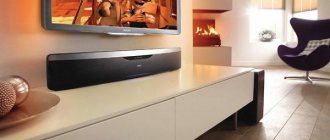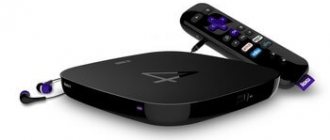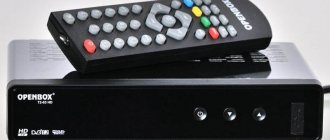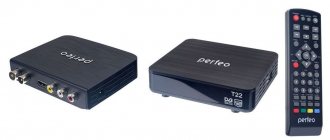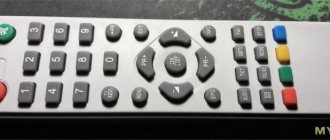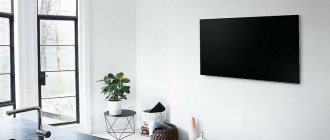Modern TVs most often have built-in speakers. But usually their power is low, and the sound from them is not very high quality. Due to the fact that TVs are becoming thinner every year, it is difficult to place speakers with high-quality sound inside them. Therefore, many users complain about poor sound. Acoustic systems and soundbars are designed to help them solve the problem and make the sound quality. Let's look at what characteristics you need to look for when choosing speakers for your TV.
Types of speaker systems
Acoustic systems are distinguished both by the design and number of loudspeakers, by their location, and by the principle of operation.
Based on the principle of operation of loudspeakers (speakers), there are two main directions:
- Electrodynamic;
- Electrostatic.
Electrodynamic system Electrostatic system
Electrodynamic ones are the most common. This is an ordinary speaker in which the diffuser is attached through an elastic suspension to a frame (diffuser holder). On the back side of the diffuser there is a coil of copper wire placed in the magnetic field of a permanent ring magnet. The diffuser creates sound vibrations, disturbing the air due to the interactions of the constant field of the ring magnet and the magnetic field of the sound signal created by alternating current through the coil. The sound quality and spectrum of reproduced frequencies depend on the material from which it is made, its geometric dimensions and shape.
Electrostatic ones have a relatively new design, a very low coefficient of nonlinear distortion (about 0.05%) and a very high price. In addition, their operation requires a special amplifier with an output step-up transformer to create high voltages. Such acoustic systems are more expensive than classic ones with electrodynamic loudspeakers. Their frequency response does not allow covering the low-frequency spectrum with small linear dimensions of the loudspeaker. Therefore, such speakers combine electrostatic and electrodynamic sound emitters, but, again, paired with an expensive amplifier. This way it is possible to achieve a relatively smooth frequency response and high sound quality.
Based on location and purpose, columns are divided into the following types:
- Floor;
- Shelf;
- Planar;
- Central plan;
- Rear;
- Frontal;
- Subwoofer.
Subwoofer Floor-standing speakers Front speakers Bookshelf system Rear ceiling system Planar system
There is also a division into:
- Active. In them, the amplifier is built into one of the speakers of the speaker system. Such speakers are most often found in the budget segment, in the home theater speaker segment and in the field of PC acoustics;
- Passive. For their operation, a separate, external amplifier is required. Such speakers were most common in the last century; most Soviet speakers were of the passive type. Now passive systems mainly occupy the middle and high price segment.
Number of columns
With all this variety of classifications, the first thing that catches your eye when choosing speakers in a store is numbers like 2.0, 2.1, 5.1, written on the boxes and price tags. In the amateur price segment, this is one of the main indicators. The designation indicates the number of speakers and subwoofers.
For information! A subwoofer is a speaker designed for low frequencies (LF). It gives deep and beautiful bass to even the smallest midrange and high-frequency speakers.
Let's move on to decoding digital abbreviations:
- 1.0 — 1 column. These are used as portable speaker systems or speakers for mobile phones. Radios and players are often built into such models, but the ability to work as a speaker always remains;
- 2.0 — these kits come with 2 front speakers. Suitable for watching TV with stereo sound in small rooms or for a computer;
- 2.1 - more advanced acoustic systems. They come as a set of 2 front speakers and 1 subwoofer. The speaker has deep bass compared to 2.0 type systems, and the speakers reproduce the range in the mid and high frequencies;
- 4.0 — two speakers for installation in front and two rear speakers. They are less common than others;
- 4.1 — two rear, two front and a subwoofer;
- 5.1 is one of the most common surround sound systems. Consists of two rear, two front, one front (front center) and a subwoofer. Great for movies and games, this sound provides deep immersion in the plot and perception of special effects.
There are also systems 7.1, 7.2, 9.1, but they are rarely used in everyday life due to their high price.
Often, in household active speakers for a TV, the amplifier is located in the subwoofer housing; if it is not there, then in the housing of one of the speakers.
Soundbar
A compact solution for improving sound quality is a soundbar - this is an acoustic system that is placed under the TV. It looks like an oblong column with a set of speakers combined in one housing.
The soundbar is placed under the TV
Its advantages are its compactness and good sound quality, but comparison with 5.1 Hi-Fi systems is pointless, also because of its compactness.
Average price category
Prices vary from 10 to 40 thousand rubles. In terms of sound quality, these models are higher than budget ones and can satisfy discerning users.
Bose Acoustimass 5
One of the expensive representatives of the middle price category. It is possible to install it on a shelf or attach it to the wall.
Characteristics:
- 4-way compact speakers.
- Magnetic protection.
- Powerful drivers.
- Price – 40 thousand rubles.
Bose Acoustimass 5 speaker system
Pioneer S-ESR2TB
Floor-standing acoustics from a popular brand are of high quality. The body is made of MDF. The assembly of the case is perfect, the design is neat and stylish, thanks to which the system will fit into any interior. There are fasteners for floor mounting. The set includes 5 speakers: 2 rear and front, 1 center.
Characteristics:
- The sensitivity of the rear speakers is 81.5 dB.
- The sensitivity of the front ones is 83 dB, and the central ones are 88 dB.
- Frequency – 30-40 thousand Hz.
- The central element is two-lane.
- The front element is three-strip.
- Cost – from 21 thousand rubles.
Speaker system Pioneer S-ESR2TB
Harman Kardon HKTS 30
Accommodates an active subwoofer. Suitable for installation in home cinema. The design is modern, stylish, elegant - the glossy white shade attracts attention and complements the interior. It is the appearance that is the main difference between the system. But the sound quality is also excellent. Despite its compact size, the device disperses sound throughout the room. The system consists of 6 elements: 2 front and ceiling speakers plus 1 center, as well as a subwoofer to enhance the bass.
Characteristics:
- Playback frequency – 20–45 thousand Hz.
- Subwoofer power – 200 W.
- Sensitivity – 86 dB.
- Magnetic shielding.
- The price of the set is from 36 thousand rubles.
Acoustic system Harman Kardon HKTS 30
Main selection criteria
It will be quite difficult for the average person to navigate the variety of technical characteristics and features of each type of speaker. Now we will move on to consider the main technical characteristics.
Sensitivity
A characteristic that describes how sensitive the speaker system is to the input signal. Measured in dB/W/m. Tells how loud the speaker will sound in dB when a 1 W signal is applied at a distance of 1 m, measured on the emission axis. Typical sensitivity values are 84-97 dB/W/m.
Since the decibel is a logarithmic value, then increasing the volume of the speaker system by 1 dB, you need to increase its power by 1.25 times, by 2 dB - by 1.6 times, and by 3 dB - by 2 times, etc.
This means that in terms of volume, a speaker with a sensitivity of 90 dB/W/m and a power of 100 W will sound the same as a speaker with 87 dB/W/m and 200 W of power.
Sensitivity is measured by applying a signal with a frequency of 1000 Hz.
Power
Measured in Watts. It is the power of the electrical signal at the output of the amplifier; there is also the concept of speaker power, which is important when choosing speakers. The power of the amplifier is limited by circuit solutions and power elements. The power of the speakers is limited by the mechanical strength of the cones and the electrical characteristics of the coil.
If the choice is between passive acoustics options, note that the amplifier power must be less than the power of the speakers , otherwise they may fail when you turn the volume knob to maximum.
The power that the speaker can withstand for a long time is denoted by three Latin letters RMS.
Impedance
This is the total resistance of the speakers (active and inductive reactance), measured in Ohms. It is important when choosing a passive speaker - it must comply with the permissible operating modes of the amplifier.
Typical impedance values for speaker systems are 4, 6, 8 Ohms. However, it depends on frequency, which leads to dips in the frequency response of sound emitters. The higher the frequency, the higher the coil resistance. Therefore, the indicated number of ohms on the speaker is the measured resistance at an AC frequency of 1000 Hz.
Impedance graph example
For information! If the speaker impedance is lower than the amplifier's recommended load impedance, there may be increased audio distortion. Speaker impedance says little about sound quality, as it depends on the entire system.
Interfaces for connecting to a sound source
First, let's note that audio is an analog signal. However, connectors or interfaces for connecting a speaker system (amplifier) to a sound source are divided into three types:
- Analog;
- Digital;
- Wireless. They are also digital nowadays.
Important!
Consider whether the speaker plug or connector will fit those on the TV. In addition, the sound quality depends on the type of connector used. Let's look at typical connector options.
Tulips-RCA and 3.5 mm - analog connectors
To connect speakers to the TV, RCA type connectors are used, or as they are popularly called “Bell” or “Tulip”. It is a round coaxial connector with a signal plug at the end and a shielding skirt around it. Typical colors in a stereo speaker are white for the left speaker and red for the right. The sound output on a TV or player is designated as AUDIO OUT.
Tulips - RCA and 3.5 mm
At the same time, speakers are connected to wearable players, phones and computers via a 3.5 mm connector; by the way, this is also found on some portable TVs. Both connectors are analog.
Advice! There are cords available for sale - RCA-RCA, RCA-Jack 3.5 mm, Jack 3.5 mm-Jack 3.5 mm, the latter is often called an AUX cable. Therefore, you can always find the right option for your system.
Universal SCART connector
It is used for both video and audio transmission, and also transmits a digital signal - commands to the TV. Currently going out of use.
Universal SCART connector
Optical interface
Serves to transmit digital images and audio signals. Provides high quality sound.
HDMI connector
A modern connector for transmitting digital signals (information, video and audio). Provides sound quality and is supported by the vast majority of modern technology.
HDMI connector
In addition to transmitting an audio signal, in advanced models of TVs and speakers it becomes possible to control the volume of speakers connected via HDMI. The ARC audio channel provides such opportunities. In addition, you can broadcast sound from other devices connected to the TV (set-top box, player, tuner).
Wireless signal transmission
Bluetooth and Wi-Fi have become the basis of modern communications. The Internet and data are most often transmitted through these technologies. There are a lot of speaker systems on the market that work via Bluetooth. Xiaomi is making good progress in this direction. However, there are certain nuances:
- The quality is close to the CD-audio format;
- The main scope of application is related to portable speakers and small systems of the 2.0 - 2.1 type; due to technological factors, it will not be possible to fully reveal the advantages of 5.1 systems and the like.
Housing material
Both sound and performance characteristics depend on the choice of material. Speaker systems are made from:
- MDF. The most common option gives good sound and is light in weight, but over time the corners of the speakers wear out and peel off;
- Chipboard. Used less often, weigh heavier;
- Tree. Quite rare, they give a good sound, but it also depends on the type of wood;
- Plastic. A cheap and lightweight material, its disadvantage is that it is fragile and easily cracks upon impact.
Speakers made of wooden materials System made of plastic
For information! Acoustics made of chipboard and MDF do not tolerate moisture well - this is important if you plan to install them, for example, on a windowsill. There are also metal cases, for example made of aluminum - but keep in mind that this is not the best material for sound transmission, but they are durable.
LG SL8Y
This compact device allows you to recreate the sound of a movie theater at home. This is made possible by supporting Dolby Atmos and DTS:X technology. The soundbar reproduces digital music of the highest quality. There is support for 4K HDR content.
Main characteristics of the model
- standard: 3.1;
- dimensions of the main module (WxHxD): 1060x57x119 mm;
- subwoofer dimensions (WxHxD): 221x390x313 mm;
- main module weight: 4.4 kg;
- subwoofer weight: 7.8 kg;
- total power: 440 W;
- number of columns: 1 pc.
Advantages
- + stylish appearance;
- + can be connected via optical cable, HDMI or Bluetooth;
- + easy controls;
- + there is an application that can be installed on your phone and control the soundbar via your smartphone;
- + simple and clear connection;
- + watching Netflix series is now a pleasure;
- + you can listen to music from your phone;
- + passing games has reached a completely new level;
- + you can use the TV remote control to control the soundbar;
- + Compatible with Google Assistant.
Flaws
- — the body is very long;
- — to connect Bluetooth, you need to additionally install the Google Home program;
- - high price.
Best deals
8.
Model rating
Let's look at some interesting models from different price ranges.
Budget models
| Model | Characteristics |
| Microlab M-1910 Acoustics 5.1 for $120, the Microlab company produces quite high-quality products in the lower and middle price segments. A total power of 45 W, a subwoofer with a bass reflex, the body is trimmed with plastic panels. Pros:
Cons: none found. | |
| SVEN HT-200 A budget model costing 80-90 dollars in an MDF case. The products of the manufacturer SVEN have been on the market for more than 15 years and in this price segment they have very good quality. The total speaker power is 60W. The declared range of reproduced frequencies is 40-22000 Hz. Pros:
Flaws:
| |
| Gemix HT-1050 Ultra budget 5.1 system for $70. She has plastic speakers and a subwoofer made of MDF. Claimed total power 60W. Pros:
Cons: the speakers do not have mounts for hanging on the wall. |
Average price range
| Model | Characteristics |
| Edifier R501T III 5.1 speakers from a well-known manufacturer of inexpensive speaker systems. The cost is about 170 dollars. Edifier has a fairly wide range of models. It began to actively develop in the domestic market about 10 years ago, during which time it managed to show itself quite well in terms of quality and reliability. Pros:
Disadvantages: there are no volume controls on the subwoofer, all settings can only be made using the remote control. | |
| F&D F5060X Large home theater speakers with a total power of 60W for $170-180. F&D products are often very similar to the SVEN brand. The quality of this manufacturer is quite good. This model supports Bluetooth for wireless music playback and has a built-in simple player. Pros:
Disadvantages: none found. | |
| Genius SW-HF 5.1 6000 Speakers for almost $200 will delight the owner with good surround sound. Total power - 100 W. Pros:
Flaws:
|
Premium models
| Model | Characteristics |
| Soundbar LG SJ5 Miniature and loud acoustics for TV. Its cost is 300 dollars. Looks quite stylish. Total power 120 W. Pros:
Disadvantages: slightly overpriced. | |
| Powerful M-Audio HCS-9950 MKIII system Your neighbors will experience the most emotions! Its declared power is 420 W. 5 speakers, 2 of them are tall floor-standing, stylish design, clear sound. The body is made of MDF, like most modern models. Pros:
Disadvantages: none found. | |
| Microlab H-600 Beautiful and powerful speaker system (270W) 5.1 system, with high front speakers and a good subwoofer. Cost about 400 dollars. Pros:
Disadvantages: with prolonged use, problems may occur with the control unit or remote control. |
Top 3 Xiaomi acoustics for TV
Home Cinema Xiaomi Mi Home Theater
The wireless connection via Bluetooth 4.1 will be smooth and free of interference. The panel has several connectors and ports (USB, HDMI, Ethernet, AV), and a Wi-Fi module.
High and low registers sound harmoniously, from the effect of real presence you enjoy music and watching a movie from the heart.
The speakers deliver powerful stereo sound using Dolby Audio and DTS-HD audio decoders.
Soundbar Xiaomi TV Soundbar (white)
Lightweight, compact attribute has low weight and minimalist body design. Speakers in the amount of 8 pcs. protected from dust by material that resembles eye-catching denim.
The side panel has a clear connection interface with indicators. Playback and listening are convenient at a maximum distance of up to 10 m. The sound is clear and spacious.
Tips for choosing a speaker system
- Decide on the power range of the speaker system. There are complex formulas for calculating it, but it’s worth remembering one thing: if the speakers are too loud, you can always make them quieter, but vice versa, not. For a room measuring about 20 square meters. m. It is worth taking a closer look at models with a power of 35-50 W;
- Decide on the system format; if you will mainly watch clips and listen to music on the TV, then a 2.0 or 2.1 system will be perfect, but for watching movies or games, 5.1 or more will be better.
- You shouldn’t chase a brand; now there are products of good quality from little-known manufacturers on sale, you can listen to them in real stores and compare.
Video on how to choose a speaker system for your home
Pros and cons of external speakers for TV
The main advantage of a separate speaker system is sound quality. The user hears quiet rustles, halftones and nuances of intonation. The channels are well balanced, so high sounds do not hurt the ear, and low sounds do not hum or cause unpleasant vibration in the speakers.
However, it is worth noting a number of disadvantages inherent in these speakers:
- additional costs for the purchase of the equipment itself and cables for connection;
- difficulty of selection;
- mandatory installation and configuration of the system;
- the need to allocate space for all elements, some of which (in some sets) will need to be mounted on the wall.

